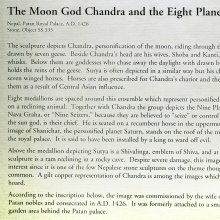Paran, Parāṅ, Paraṇ, Paraṉ: 8 definitions
Introduction:
Paran means something in Hinduism, Sanskrit, Hindi, biology, Tamil. If you want to know the exact meaning, history, etymology or English translation of this term then check out the descriptions on this page. Add your comment or reference to a book if you want to contribute to this summary article.
Paran has 6 English definitions available.
Images (photo gallery)
Languages of India and abroad
Sanskrit dictionary
[Deutsch Wörterbuch]
Source: Cologne Digital Sanskrit Dictionaries: Böhtlingk and Roth Grosses Petersburger WörterbuchParāṇ (पराण्):—(von an mit parā) adj. [Pāṇini’s acht Bücher 8, 4, 20,] [Scholiast]
Source: Cologne Digital Sanskrit Dictionaries: Sanskrit-Wörterbuch in kürzerer FassungParāṇ (पराण्):—Adj. [Pāṇini. 8,4,20,Sch.]
Sanskrit, also spelled संस्कृतम् (saṃskṛtam), is an ancient language of India commonly seen as the grandmother of the Indo-European language family (even English!). Closely allied with Prakrit and Pali, Sanskrit is more exhaustive in both grammar and terms and has the most extensive collection of literature in the world, greatly surpassing its sister-languages Greek and Latin.
See also (Relevant definitions)
Starts with (+239): Para-naricakotaran, Parakara, Parakata, Parakpushpi, Paramcata, Paramciya, Paramciya, Paramdama, Paramdhama, Paramdhamarupa, Paramgama, Paramgamana, Paramgamana, Paramgamate, Paramganavirati, Paramgane, Paramgate, Paramgaya, Paramgiakkihullu, Paramgicekke.
Ends with (+7): Acamparan, Acaraparan, Acuyaparan, Anniyaparan, Atiparan, Camparan, Camputarparan, Caparan, Cirparan, Ekamparan, Kantaparan, Karparan, Kuruparan, Nana-kuruparan, Nanaparan, Parama-paramparan, Paramparan, Paraparan, Pukaipparan, Samparan.
Full-text (+35): Paranc, Pukaipparan, Paranmukham, Paranmukhatva, Paranmukhabhuta, Paranmukhata, Paranmukhikri, Paranmukhaya, Paranavritta, Paranmukhibhu, Paranmanas, Parantapan, Parana, Paran Mukha, Titiparan, Aparanmukha, Atiparan, Nanaparan, Parananti, Erumatam.
Relevant text
Search found 10 books and stories containing Paran, Parāṅ, Parāṇ, Paraṇ, Paraṉ, Paaran; (plurals include: Parans, Parāṅs, Parāṇs, Paraṇs, Paraṉs, Paarans). You can also click to the full overview containing English textual excerpts. Below are direct links for the most relevant articles:
Tiruvaymoli (Thiruvaimozhi): English translation (by S. Satyamurthi Ayyangar)
Pasuram 3.3.8 < [Section 3 - Third Tiruvaymoli (Olivu il kalam)]
Pasuram 4.10.3 < [Section 10 - Tenth Tiruvaymoli (Onrum-tevum, ulakum)]
Pasuram 1.1.11 < [Section 1 - First Tiruvaymoli (Uyarvu ara Uyar Nalam)]
Garga Samhita (English) (by Danavir Goswami)
Verse 6.2.12 < [Chapter 2 - Residence in Śrī Dvārakā]
Chaitanya Bhagavata (by Bhumipati Dāsa)
Verse 2.6.172 < [Chapter 6 - The Lord’s Meeting with Advaita Ācārya]
Shrimad Bhagavad-gita (by Narayana Gosvami)
Verse 9.21 < [Chapter 9 - Rāja-guhya-yoga (Yoga through the most Confidential Knowledge)]
Early Chola Temples (by S. R. Balasubrahmanyam)
Temples in Nangavaram (about the 10th year) < [Chapter X - Historical Survey]
Temples in Tirukkalittattai < [Chapter II - Temples of Parantaka I’s Time]
Chola: Vijayalaya < [Chapter XIV - Conclusion]
Later Chola Temples (by S. R. Balasubrahmanyam)
Temples in Udaiyalur < [Chapter II - Temples of Kulottunga I’s Time]
